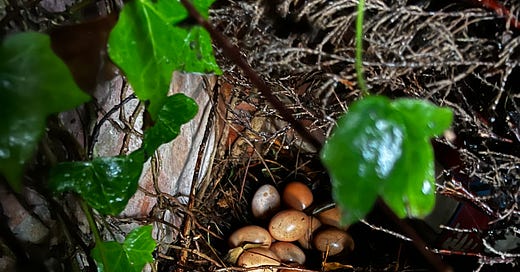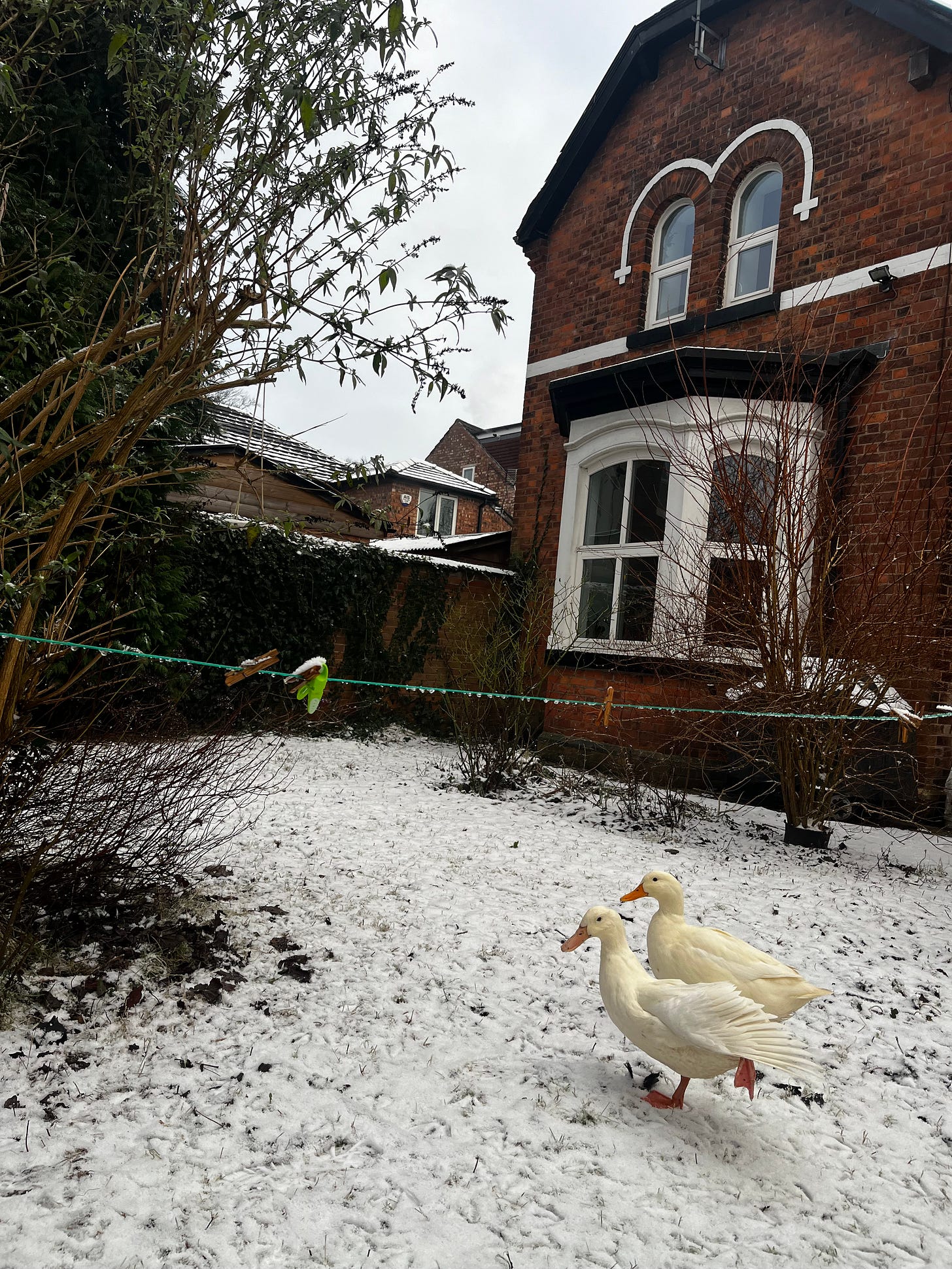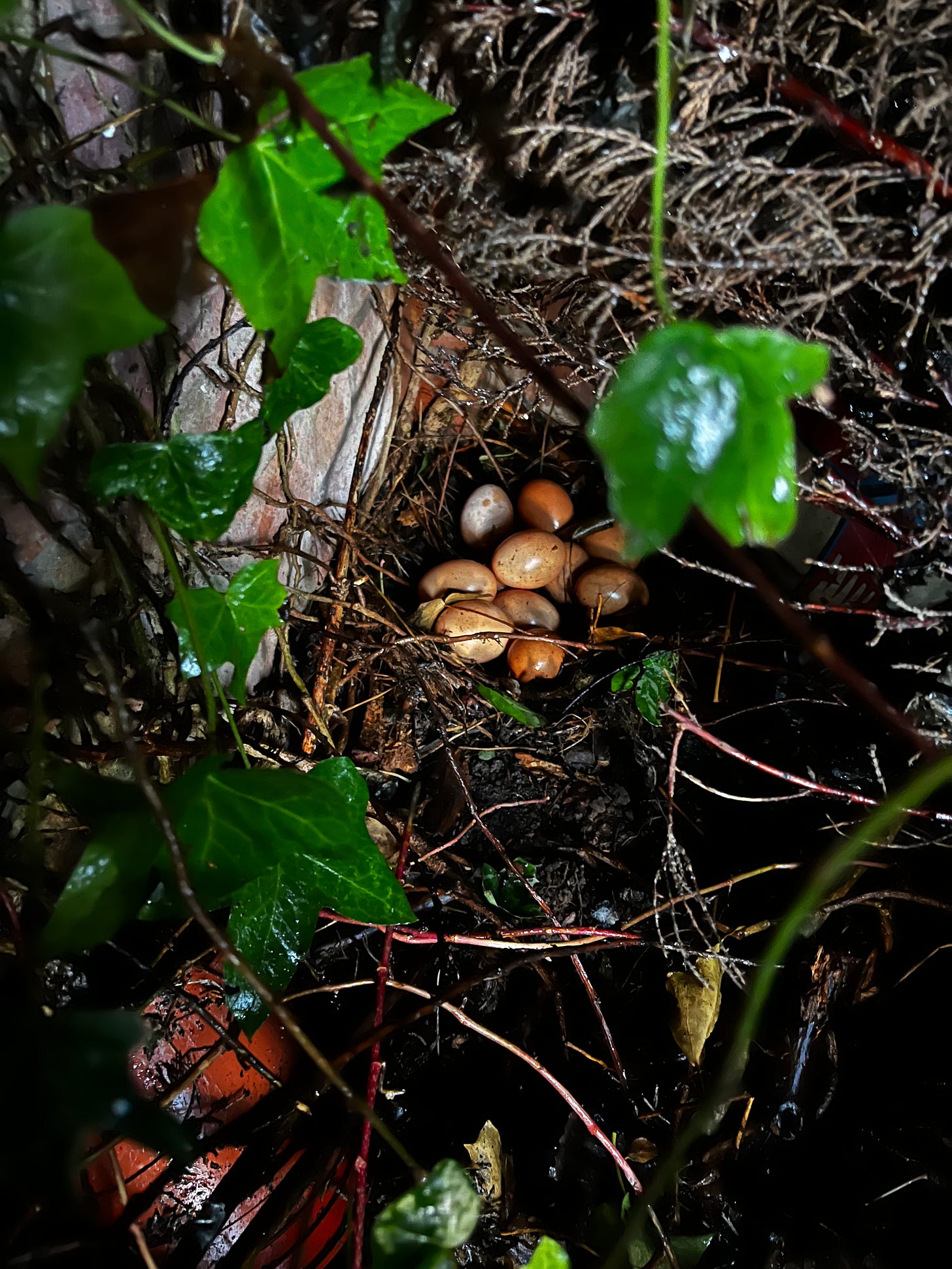The efficiency of self sufficiency in fresh pasta
Is homemade tagliatelle an efficient self sufficient swap, judged for health, sustainability and real cost?
I’m going to combine this post with a bit of journaling about life for us at the moment, more because of how it explains the pile of eggs that need using than for any other reason.
Back in May, exactly a week after giving birth to baby Flo, we moved to this house. It’s a fascinating place. A three bedroom Victorian edifice, walled in behind three streets and only accessible via its own narrow alley. Somehow simultaneously grand and small. With three spectacular cast iron weather veins and garden on three sides. The garden is pretty glorious if a little out of shape and is the very first proper garden I’ve ever had, not to mention the first garden with REAL trees. It’s resulted in all sorts of interesting conundrums such as what to do with fallen leaves. There are nooks and crannies everywhere which I’ve been gazing at and dreaming of what to do with while recovering from C section and figuring out how to look after a tiny human. Tree houses, dens, sun rooms and a better water collection system all lie in my future with any luck.
Not long after, we had to say goodbye (some more viscerally than others) to one of our chickens. And as a way to cheer me up, Matt dragged me over to the nearest farm shop just before winter to ‘enquire about’ getting more. I have always wanted to hatch out my own little chicks so that was my plan but what I actually did, adrenalin coursing through every vein in my body, was impulse purchase two ducks. The sheer impractical joy of it all felt like I used to feel doing extreme sports in my 20s. And the 10 week old ducklings still had their baby fluff as well as the most adorable little coots so a number of boxes were ticked that Monday.
Anyway I love them, they’re my most prized possession (sorry Florian) but it’s a bugger learning how to look after a mixed flock, especially when you add in the needs of the neighbours with their footballs going over the fence and the postwoman who appears to be scared of some element of the set up and now just lobs our packages over the gate. To be shat on by the chickens and ducks. It’s not quite what you’d expect from an urban round I suppose.
One of the things I’ve experimented with doing is keep the ducks back in the run for feeding and lock the chickens out for a couple of hours. Long story relating to poultry and their arsey attitudes with each other which I’ll go into separately. However, there was an immediate and unfortunate egg reduction. So when, while Matt was off for Christmas, I was offered up a magnificent couple of hours to spend in the garden, I took the opportunity to have a poke around. And behind the biggest, shagiest tree, beneath a surprising amount of dog balls, I found a somewhat adorable nest with around 15 eggs. Time to roll up my sleeves and get my Farmer’s Wife game on the go.
I had originally planned to turn all of them into a few of kilos of fresh pasta for freezing and cooking on future occasions but in the end Matt was back late and the baby was poorly and I drastically underestimated how long pasta takes so I made enough for two meals, rolled half out for dinner and froze the rest. As this is the first time I’m attempting to evaluate this on my efficient self sufficiency matrix and I don’t actually have a matrix yet I’ll simply look at it from the three perspectives I set up and draw some initial conclusions both about the food product itself and how to build a good sturdy system of evaluation.
Homemade vs shop bought vs handmade fresh tagliatelle
I did have a quick glance around other retailers in case any were completely different but am largely comparing with Tesco’s standard range of fresh tagliatelle. Let’s not open the can of worms marked ‘fresh vs dried’.
Preparation method
I used my standard pasta recipe which is 100g flour to each egg plus a pinch of salt. I should do this more scientifically in the future but we ate around 2 eggs worth of pasta. Probably should have pinched more generously on salt. I kneaded the dough in my stand mixer which made an alarming sound and produced tears from the baby then ran it through a pasta machine. The dish was served up in a simple sauce of butter, garlic, tomato and spring greens, drizzled with olive oil before serving. I’m just costing up the pasta here though as that’s the self sufficient practise I’m analysing. I definitely think there’s an argument for very homemade stuff being more simply served but that’s not what I’m getting at right now.
Health
Because I was adding 2 eggs each to this and serving it with red and green veg, I judged it to be nutritionally adequate for our evening meal. The supermarket equivalent also contains semolina and the egg is pasteurised but other than that the ingredients are the same. There are no UPFs to worry about here and there doesn’t appear to be an excess of any high risk ingredients.
I am comparing the nutritional value of a portion here not the nutritional value per 100g. So a standard portion of homemade pasta is 1 egg plus 100g flour which is a little more than the supermarket where it’s half a 300g pack. I think this is relevant. The supermarket can point to whatever portion size it chooses for something like fresh pasta and a slightly short portion size of a cheap element may result in the eater choosing to subsidise with a more expensive ingredient or add a pudding or whatever. Or maybe Matt and I are greedy.
The main difference is that the supermarket version contains only 20% egg. That gives us 6.9g of protein per portion of supermarket fresh pasta (according to the Tesco’s website), vs 16g of protein in the homemade equivalent*. This points towards the need to add something in to the supermarket pasta to achieve a nutritionally balanced meal.
Overall though, I’d say the supermarket equivalent doesn’t rate too badly but I would note that as soon as we begin to venture into the world of tortelini or ravioli the ingredients list in the supermarket equivalent explodes and begins to contain a number of ultra processed ingredients. Definitely one to compare in the future, not least because when you’re in the supermarket it’s just so easy to grab a filled pasta. And because I actually think it’s easier to make ravioli at home than having great tentacles of pasta hanging on all my dining room chairs and getting stuck to everything while I’m rolling out tagliatelle.
*A lot of this is down to the protein in the flour and I think milling your own could be a great way to improve the nutrition in your food but for now I’m just going off what google tells me.
Sustainability
I guess the main sustainability concerns here are the various shipping, packing, processing questions which would apply to any packaged food product, including the need for consistent refrigeration from production to plate. The pasta is made in Italy (I somehow can’t help but eye roll at this) so that’s no mean feat. Tesco appear to have recently switched to packaging their dried product in paper but this is still in ‘recyclable’ plastic.
Let’s assume that the product is imported by refrigerated lorry. I went back to my old mate Chat GPT and it calculated that the carbon footprint of my pasta, while still sitting on the shelves, is 0.55kg. Of this just over half the footprint is ingredients and a quarter each for packaging and transportation. Now I cross referenced this with the data of a lovely chap called Mike Berner Lee who has produced a chart of the carbon footprint of what we eat. The calculations are equivalent (sometimes it’s good to mark the work of ChatGPT). What I’m trying to do here is figure out a high or low score for the sustainability of the product but I’m realising that doesn’t make sense. Chilled pasta imported from Italy has a high footprint within the category of starches and carbs but is nothing compared to meat or out of season fruits. I need to figure out a better way of analysing this.
The other thought is the standard of production of the eggs. I do worry about dirivative products in supermarkets and the ethical consideration for their ingredients which are often far more murky than buying the ingredients on their own*. It appears that the Irish version of this pasta does contain free range but the egg is not pasteurised like in the British version so I’m forced to conclude the egg is not free range in this instance. This may be a no go for many but as M&S tagliatelle is made with free range eggs and is not significantly different in price (£4.60 per kg as opposed to £4.50) I will proceed and try to shop in M&S for pasta in future. We learn.
*I’ll return to this in discussion of the ‘Thai chicken’ listed as an ingredient in a curry recently.
Real cost
This one’s the killer. Pasta making is laborious! I don’t make it that often so am probably not as quick as I could be. I’ll gloss over the calculations for labour here and explain in another post, suffice to say that I’m costing my labour for now at £17 per hour. I haven’t included depreciation of the kit which is particularly relevant as the stand mixer began actually smoking while mixing the pasta (lending a bit of a Chitty Chatty Bang Bang air to proceedings) but basically I’m just well eager to get going and it all needs refining at a later date.
Shop bought:
Tesco fresh tagliatelle nests £1.35 for 300g which would be enough for a meal for two so 67p a portion.
Homemade:
Egg: We have chickens which I think costs us in feed around 13p an egg.
Flour: I’m afraid I didn’t use 00. We get organic stoneground flour by the sack full which comes to around 90p a kg
Labour: Wow. It’s the rolling isn’t it? If anyone has a better way I’m all ears but for now I’ll have to go with 24 minutes of pure labour (as opposed to doing something else while it’s in the mixer) equating to £5.10. I did make the second batch of dough without rolling it but the mixing stage is just not significant in this process.
Utilities: I’ll be honest, I just ran this one through Chat GPT. It reckons the use of the stand mixer would be about 3p. I didn’t mention about the smoke for fear of it turning the machines against me.
Total: £2.79 per portion
Handmade:
As opposed to homemade. The Pasta Factory based in Manchester lists handmade on site tagliatelle as £6 for 2 portions. I won’t look into this too closely here as the shop bought and homemade are too similar.
Taste
Not really a factor in this investigation is it? Not because it’s not important, I estimate taste to be my primary raison d’être. But because so many people write about how homemade tastes better that I don’t think it should come as a surprise. Needless to say, I enjoyed it. Not sure about Matt. He returned home in sub zero conditions to a snotty baby that was fundamentally opposed to going to sleep and didn’t seem that focused on the finesse of the pasta strips or the delicate drizzle of olive oil.
Conclusion
I think I’m going to have to rate fresh pasta amber. Although the nutritional density is improved by making your own, I can’t see any red flag ingredients in the shop bought option and the real cost of around £3 a portion is around 5 times the shop bought version. I’m sure I read somewhere that Italians don’t much go in for homemade pasta, maybe this is why.
I do think it’s important that I would be likely to add another protein source to this meal if it were shop bought pasta both for reasons of ‘specialness’ of meal and for nutritional density but that’s not the game is it? I’m not going to change the rules at this early point just to try and prove my thesis.
I also think the sustainability of the shop bought option is pretty unacceptable for pasta having undergone the analysis. This is definitely something I’d look to alter when shopping for pasta in the future.
A fitting conclusion of the story is that we still haven’t had any duck eggs and we got the ducks in October. I’ve read that ducks can lay anywhere so who knows where I might need to poke around to reveal a stash of lovely big duck eggs. Duck eggs are a different kettle of fish as they contain more protein per gram so maybe this is something to revisit with a little batch of duck egg ravioli.







Thank you for the run down. My fav to make is ravioli which is our hay making dinner. When I do go to the effort of making pasta I make enough to freeze. I freeze the ravioli free flow so I can just reach in and grab enough for dinner when we have been in the fields all day . It is a messy business! We have chickens and I literally grow my own organic wheat flour so - yeah - pretty cheap!
Your ducks are just perfect!
Was the tesco pasta made with organic flour? That would surely make a difference in price. I personally think homemade pasta is so much tastier so couple that with the fact that you had your own eggs and organic flour surely that raises the level a little 😂
Well done for working it all out!